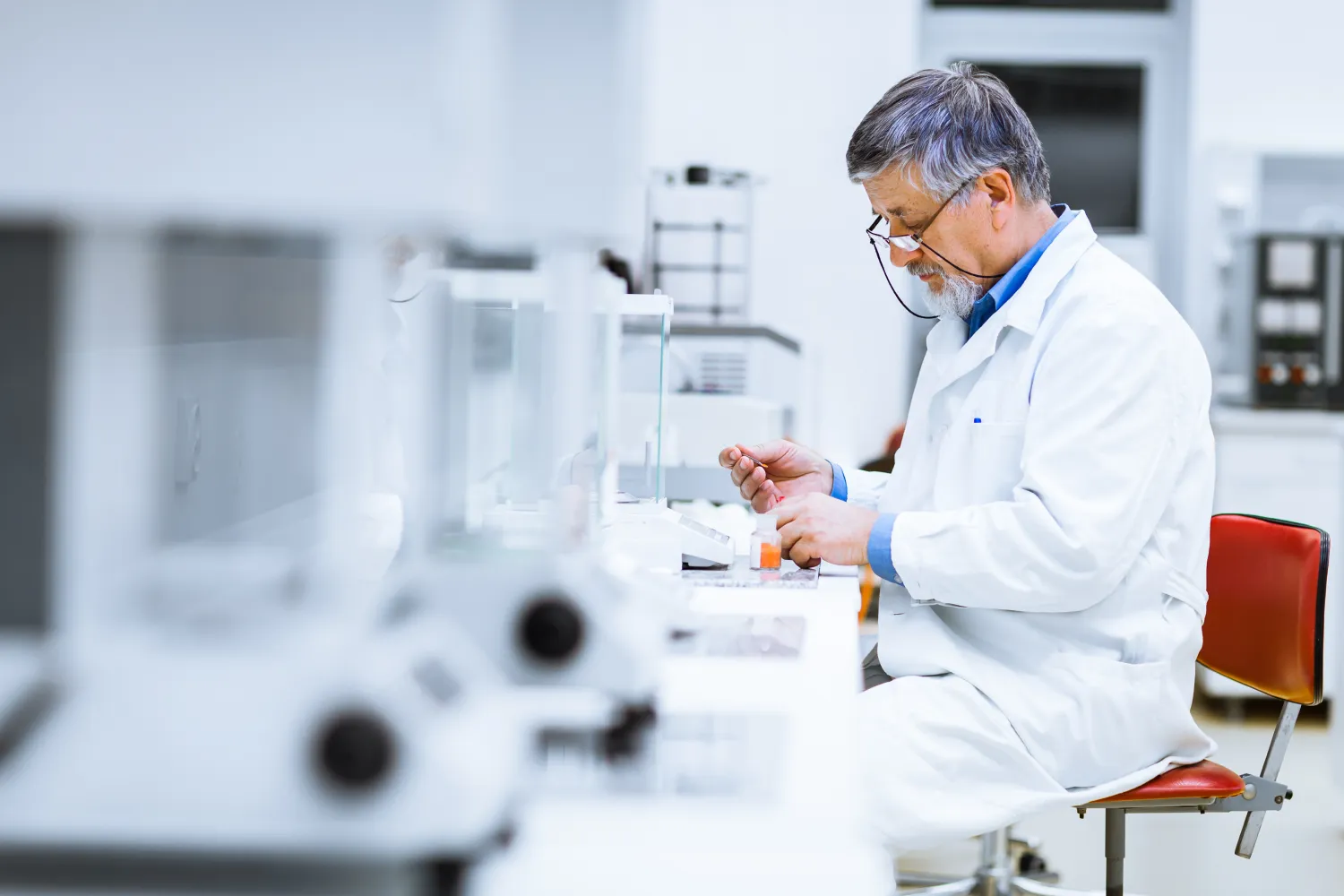Reviewed by | Melinda Hany, Registered Nurse
Centrifuges are used for a variety of scientific, industrial, and clinical applications, including the separation of blood samples. This process is commonly used to distinguish the different components of a blood sample, such as red blood cells, white blood cells, and platelets, by applying rotational forces that separate these components based on weight, size, and density.
Because of this ability, centrifugation is essential for accurately diagnosing many diseases and other medical conditions. To fully understand how centrifugation plays a role in blood samples for clinical research, we must first understand what a centrifuge is.
What Is a Centrifuge?
A centrifuge is a machine that spins a tube or other container of liquid at high speed, creating a force that is strong enough to separate materials based on density. The centrifuge rotation causes the sample’s heaviest components to settle to the bottom while lighter components remain suspended in the liquid.
“This process of centrifugation can be used to separate a variety of materials, including proteins, cells, and other particulate matter,” notes Melinda Hany, Registered Nurse. Centrifugation is also used to purify and concentrate samples and can provide detailed information about their constituents.
Centrifuges come in many different sizes, ranging from small tabletop units to large industrial units. Centrifuges can be further divided into two types: fixed-angle centrifuges and swing-bucket centrifuges.
Fixed-angle centrifuges have a fixed angle of rotation, which is used to separate components in a sample based on their densities. Swing-bucket centrifuges, on the other hand, have moveable buckets that can be adjusted to different angles of rotation.
One of the benefits of using a fixed-angle rotor for centrifugation is that it can produce consistent results based on density. This is because the angle of rotation is fixed, so the components in the sample spin at the same speed and experience the same force.
This ensures that the same components always settle to the bottom, resulting in reproducible centrifugation results. Additionally, fixed-angle rotors are more efficient than swing-bucket rotors, as they require less time and energy to manipulate the components.
On the other hand, swing-bucket rotors have several advantages over fixed-angle rotors in certain situations.
They are able to accommodate a wider range of sample sizes and volumes due to their flexibility and their ability to process samples at different speeds and angles. In addition, swing-bucket rotors are able to process samples with larger sedimentation rates, meaning that they can separate more components in a shorter amount of time.
How Are Centrifuges Used in Clinical Research?
Centrifugation is commonly used to separate components of a blood sample. Centrifuges can separate red blood cells and white blood cells from each other as well as from other components, such as platelets.
The centrifuge process is also used to isolate proteins and other molecules from the sample. By varying the speed of rotation, the centrifuge can be used to separate components with different densities and sizes. Centrifuges are used in clinical research to isolate and study these components of a blood sample.
Different types of centrifuges are used for different applications. For instance, a high-speed benchtop model might be used for cell separation, while a larger, floor-standing model might be used for high-volume sample processing. Different assays necessitate serum or plasma, which can be obtained with centrifugation.
A serum sample is obtained by letting a whole blood sample clot at room temperature. The sample is then run through a centrifuge to remove the clot, leaving behind the serum supernatant.
Unlike serum, plasma is obtained from whole blood containing serum and clotting factors, meaning it is not left to clot. To obtain plasma, a whole blood sample is collected using tubes containing anticoagulants to prevent clotting. Following centrifugation, the blood cells are separated from the plasma supernatant.
By isolating different components of a blood sample, researchers can gain valuable insight into various medical conditions and develop treatments for them. The precise and efficient separation provided by centrifuges provides essential information for medical research.
Integrating centrifugation as a process in a study protocol can be time-consuming and costly. However, in one study, researchers found that centrifugation times of 7 or 10 minutes provided nearly identical test results compared to the 15-minute time proposed by the World Health Organization (WHO).
They believed that this was due to the improved sample preparation and centrifugation parameters used in the study. Therefore, they concluded shorter centrifugation times could result in more efficient laboratory operations, with fewer errors due to sample contamination and longer waiting times. Thus, shorter centrifugation times may improve test accuracy and patient outcomes.
Why Are Blood Samples Essential for Medical Research?
Blood samples are essential for medical research, as they provide a direct window into an individual’s health and biochemistry. By analyzing the components of blood, researchers can identify disease markers and gain insights into the underlying biology of a condition.
Blood samples also allow researchers to track a disease’s progression and assess treatments’ effectiveness over time. For example, they can be used to study the effects of drugs, monitor levels of hormones in the body, and analyze markers of disease or damage.
In addition, blood samples are also used in genetic research, allowing researchers to identify genetic links to specific diseases and conditions. Researchers and clinicians can compare individuals’ genetic profiles and help identify predispositions to certain conditions by analyzing processed blood samples.
How To Choose the Right Centrifuge
When choosing the right centrifuge for blood samples, it is important to consider the type of separation needed and the speed at which it should be done.
Consider the Type of Centrifuge
Fixed-angle centrifuges are best suited for separating components of similar density, while swing-bucket rotors are better for samples with larger sedimentation rates. It is also important to consider the size and capacity of the centrifuge, as well as any other features that a particular project may require.
The size of the centrifuge is also important as it determines the amount of sample that can be processed at once. This can be especially important for large clinical or research laboratories, which often need to process a large number of samples quickly. Smaller centrifuges are more suitable for smaller samples and can be used in the home or in small laboratory settings.
Consider Sample Volume
When considering which centrifuge to invest in, the volume of samples required for specific projects is critical. The volume of the sample can determine whether a smaller or larger centrifuge is necessary.
A floor-standing centrifuge model with a higher capacity and different rotor configurations may be the best solution for processes involving large or varying volumes. A tabletop centrifuge is often sufficient for smaller volumes and can save time and money.
Consider Safety and Maintenance
In addition to centrifuge size, design, and functionality, one should consider safety precautions when operating a centrifuge. Centrifuges should be placed in a well-ventilated area away from combustible materials.
All necessary safety guards should be in place, and protective barriers and gloves should be worn when necessary. It is also important to ensure that the centrifuge is properly balanced and that the rotor is securely fastened before use.
Balancing a centrifuge is an important part of the process and helps ensure the sample’s quality. To achieve the best results, it is important to use the right balance weights and adjust them accordingly.
The weight should be adjusted until the rotor is completely balanced, ensuring that the sample is evenly distributed and that the centrifuge operates at a consistent speed. Additionally, regular calibration of the centrifuge should be done to ensure the accuracy and reliability of the results.
Where To Obtain Blood Samples
Whether processing blood samples via centrifugation in your own lab or acquiring pre-isolated samples from an online vendor or biorepository, there are certainly numerous options when it comes to fulfilling blood sample requirements in clinical trials.
In clinical research, obtaining quality blood samples can be a challenge. Depending on the study, the sample size needed may be too large for a single laboratory or biorepository.
In those cases, the study sponsor may acquire samples from multiple sources. Online vendors are a convenient source for acquiring blood samples, as they can provide access to samples from all over the world.
The Bottom Line
A centrifuge is a clinical device that uses high speeds and levels of force to separate blood components. This is largely helpful in clinical and research settings where the diagnosing or researching of a particular issue requires an isolated blood component.
At iProcess Global Research, you’ll be working with an internationally integrated team that can provide biospecimens such as blood samples from over 1,000 different sites on six continents. iProcess has the experience to fulfill the research requirements of even the most demanding study protocol. Contact us today to see how iProcess can help you in your research.
Sources:
Optimizing centrifugation of coagulation samples in laboratory automation | PMC




